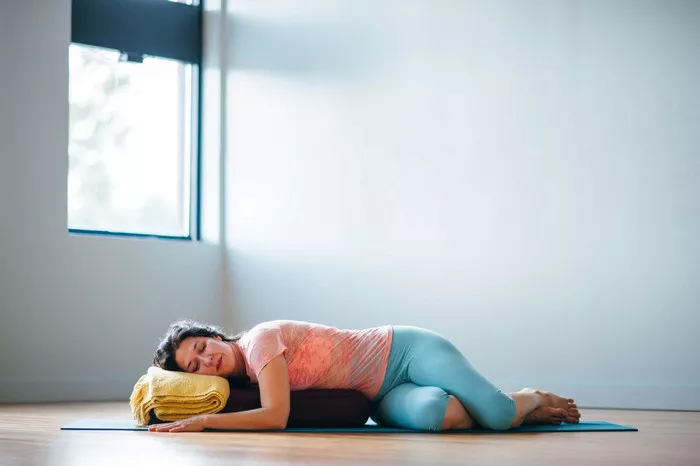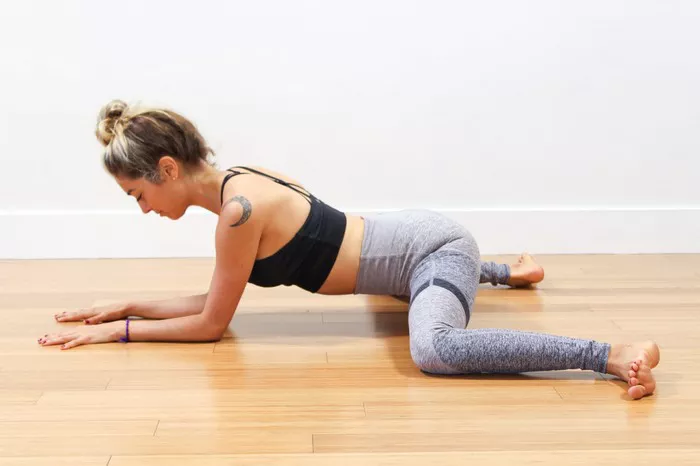Vajrasana, often called the “Diamond Pose” or “Thunderbolt Pose,” is a traditional seated yoga posture with a rich history in yoga practice. It’s commonly used for meditation, pranayama (breathing exercises), and even during the practice of other asanas (yoga poses). Though Vajrasana may appear simple, it offers a wide range of benefits for both beginners and advanced practitioners. The question of how long to sit in Vajrasana is common among yoga students, as the duration plays an important role in maximizing its benefits while avoiding discomfort or strain.
In this article, we will explore the Vajrasana posture in detail, including its benefits, the ideal duration for holding the pose, and factors that may influence how long one should sit in Vajrasana. Additionally, we’ll discuss common mistakes, modifications for different skill levels, and how to incorporate Vajrasana into your yoga practice effectively.
What is Vajrasana?
Vajrasana is a seated yoga posture where the practitioner kneels on the floor with their legs folded beneath the body. The thighs should rest on the calves, and the feet are placed beneath the hips, ensuring that the toes point backward. The spine remains straight, with the chest open and the head and neck aligned. The hands can rest on the knees or thighs, with the palms facing upward or downward, depending on personal preference.
The term “Vajrasana” comes from two Sanskrit words: “Vajra,” meaning “diamond” or “thunderbolt,” and “Asana,” meaning “pose.” The term reflects the strength and stability associated with this posture. When practiced correctly, Vajrasana offers numerous benefits for both the body and the mind.
Benefits of Vajrasana
Vajrasana is not just a simple seated posture; it provides a range of physical, mental, and emotional benefits. Some of the key advantages of sitting in Vajrasana include:
Improved Digestion: Vajrasana is known for its ability to improve digestion and stimulate the abdominal organs. Sitting in this posture compresses the digestive organs slightly, which helps to promote the movement of food through the digestive tract. This is why Vajrasana is often recommended after meals to enhance digestion and prevent issues like bloating or indigestion.
Strengthening the Spine and Posture: Vajrasana helps strengthen the spine by promoting proper alignment and posture. The straight spine in this pose can help reduce back pain and improve overall posture. It also supports the lengthening of the spine, which is essential for maintaining a healthy body in the long run.
Increased Flexibility in the Knees and Ankles: Although Vajrasana can initially feel intense for the knees, consistent practice helps increase flexibility in the knees, ankles, and legs. This can be particularly helpful for individuals with stiffness or discomfort in the lower limbs.
Mental Clarity and Focus: Sitting in Vajrasana encourages a meditative state. Its grounding nature helps quiet the mind and increases concentration. Many practitioners use this pose during meditation, pranayama, or mindfulness exercises to enhance mental clarity and emotional stability.
Enhanced Circulation: The position of the body in Vajrasana encourages proper blood flow to the lower limbs and aids in better circulation overall. Regular practice can promote healthy circulation in the body and prevent issues related to poor circulation.
Promotes Calmness: Because Vajrasana is a grounding and stable pose, it can help calm the mind and reduce stress. It is frequently used as a meditation posture because it fosters a sense of stability and tranquility.
How Long Should You Sit in Vajrasana?
The duration for which one should sit in Vajrasana depends on several factors, including the practitioner’s level of experience, comfort, and the specific goals of the yoga session. For most beginners, it’s advisable to start with a short duration and gradually increase the time spent in the pose as the body becomes accustomed to it. Below is a detailed explanation of the appropriate duration for sitting in Vajrasana based on various factors.
1. Beginners
For beginners, it’s important to build up the time spent in Vajrasana slowly. At first, holding the pose for just 1 to 3 minutes is sufficient to experience the benefits without straining the body. If you experience discomfort in the knees, legs, or hips, it’s important to listen to your body and come out of the pose as needed.
As you become more comfortable, you can gradually increase the duration, with a goal of holding the pose for 5 to 10 minutes. It’s important to ensure that your posture remains correct throughout the duration, as slouching or leaning forward can negate the benefits of the pose and lead to discomfort.
2. Intermediate Practitioners
For those with more experience in yoga, holding Vajrasana for longer durations can bring deeper benefits. Intermediate practitioners can aim for 10 to 15 minutes in the pose. At this stage, the body should be more flexible and accustomed to the pose, so you can focus on maintaining deep, steady breathing and mental focus.
Practitioners at this level may also combine Vajrasana with pranayama (breathing exercises) or meditation, further extending the time in the pose. It’s essential to maintain proper alignment during this period to prevent strain on the knees, hips, and lower back.
3. Advanced Practitioners
For advanced yoga practitioners, holding Vajrasana for 20 to 30 minutes or more is feasible. Advanced practitioners typically have a high level of flexibility and strength, allowing them to maintain the posture for longer periods. Extended sessions in Vajrasana can deepen mental clarity, enhance concentration, and promote a sense of tranquility.
In this case, the focus may be less on physical discomfort and more on cultivating mindfulness, breath awareness, or performing advanced pranayama techniques. However, it’s important to note that the duration should still be adjusted based on individual comfort and needs.
4. Post-Meal Practice
One of the unique aspects of Vajrasana is that it can be practiced after meals to improve digestion. After a meal, sitting in Vajrasana for about 5 to 10 minutes can significantly aid digestion by applying gentle pressure on the abdomen. It helps stimulate the digestive organs and supports the movement of food through the stomach and intestines. However, avoid sitting in Vajrasana for extended periods immediately after a large meal, as this may cause discomfort or bloating.
Factors to Consider for Duration
While the duration of Vajrasana varies from person to person, several factors influence how long you should sit in this posture. These factors include flexibility, comfort, the type of yoga session, and any pre-existing injuries or conditions.
1. Personal Comfort and Flexibility
Your level of comfort in the pose will directly impact how long you can sit in Vajrasana. If you feel any discomfort, especially in the knees, ankles, or hips, it’s a sign that you should shorten the duration or come out of the pose. It’s important to practice Vajrasana in a way that feels comfortable for your body.
Some people may need to use props or modifications to help them sit comfortably. For example, placing a cushion or blanket under the knees can reduce pressure on the joints, making it easier to sit in the pose for longer periods.
2. Physical Limitations
If you have knee, ankle, or hip injuries, or if you experience pain while sitting in Vajrasana, it’s essential to listen to your body. In such cases, start with very short durations (1 to 2 minutes) and gradually increase as your body adapts. Consult a qualified yoga teacher or healthcare professional for guidance on how to modify the pose for your needs.
For individuals with tight or stiff legs, it’s helpful to practice gentle stretches to improve flexibility before attempting to sit in Vajrasana for longer durations.
3. Purpose of Practice
The length of time you spend in Vajrasana can also depend on the purpose of your practice. If you are using Vajrasana for meditation, you may sit for 20 minutes or more to deepen your mindfulness and mental focus. If your focus is on improving digestion after a meal, a shorter duration of 5 to 10 minutes will suffice.
4. Alignment and Posture
The key to sitting in Vajrasana for longer durations without discomfort is maintaining proper alignment. Ensure that your spine remains straight, your chest is open, and your shoulders are relaxed. Avoid slouching or leaning forward, as this can lead to strain in the back and neck. You may also want to take breaks to change your position slightly if needed.
Modifications for Vajrasana
If you find it difficult to sit in Vajrasana due to tightness in the legs or knees, or any other discomfort, there are several modifications you can try:
Use a Cushion or Blanket: Place a cushion or folded blanket under your hips to elevate the pelvis. This modification can ease the pressure on the knees and help you maintain a more comfortable sitting position.
Sit on a Chair: If sitting on the floor is too difficult, consider using a chair as an alternative. Sit with your feet flat on the ground and your spine straight, ensuring you maintain proper posture.
Use Props for Support: Place a rolled-up towel or a block under your knees for extra support, particularly if you have tightness in the knee joint.
Legs Apart: If sitting with the legs tucked under the body is uncomfortable, you can try sitting with your knees slightly apart while keeping the rest of the posture intact.
Conclusion
In summary, the duration for which you should sit in Vajrasana varies according to your experience level, comfort, and goals. For beginners, starting with 1 to 3 minutes is ideal, gradually increasing the time as you gain more flexibility and strength. Intermediate practitioners may aim for 10 to 15 minutes, while advanced practitioners can hold the pose for 20 to 30 minutes or more.
Regardless of the duration, it’s essential to listen to your body and maintain proper alignment during the pose to avoid discomfort or injury. Vajrasana can be a valuable tool for improving digestion, strengthening the spine, promoting mental clarity, and enhancing overall well-being. By practicing this pose regularly and gradually increasing your time in it, you can experience the full benefits that Vajrasana has to offer.
If you’re new to Vajrasana or encounter any challenges during practice, remember that yoga is a journey, and gradual progress is key. Consider working with a qualified yoga teacher who can guide you in perfecting the posture and customizing the practice to suit your unique needs.
Related Topics:


























